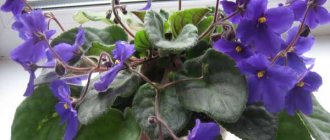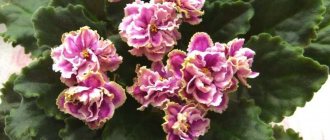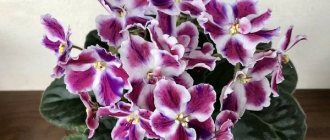The violet has a rich and wonderful past. This modest, lovely spring flower was loved in all European countries by kings, poets, and ordinary people. In France, in the vicinity of Nice and in Northern Italy near Parma, the fragrant Parma violet has long been cultivated, which was used in perfumery to produce expensive perfumes.
|
But all this, one might say, is in the past. And then the fashion for violets passed, and they were forgotten for several reasons: at the beginning of the twentieth century, the fashion for African Saintpaulias came to Europe, and large flower producers switched to growing and selling them. With the development of chemistry in the perfume industry, natural violet oil began to be replaced by cheaper chemical substitutes, and the industrial importance of violet fell.
The fragrant violet was one of the first to be introduced into cultivation in Europe, then the mountain violet. The most common violets in ornamental gardening today are: fragrant (Viola odorata), horned (Viola cornuta), Labrador (Viola labradorica), sister (Viola sororia) and modern hybrids. Gardeners love to grow pansies, whose scientific name is Viola x wittrokiana.
Chimera violet variety DS Lavender Tale
is semi-mini in size . The leaves are heart-shaped with slightly pointed ends, light green in color. The rosette is compact, regular, and sometimes there is a slight drooping of the leaf plates.
Violet Lavender Fairy Tale is a mini variety.
The flower stalks are low, each producing several buds . The flowers are medium-sized, simple, five-petaled. In terms of color, the variety belongs to the chimeras (the color of the flowers has a stripe in the center). Chimera violet DS Lavender Fairy Tale has a lilac color with a dark purple stripe in the center of the petal. The stripe is not clear, intermittent, similar to an uneven stroke.
Flowering is unfriendly, it is almost impossible . When the bud opens, it has a dark color, without a pattern; as it opens, the color changes, and light fragments gradually appear. The leaves, on the contrary, gradually darken as they grow and age.
Important! Some inexperienced flower growers, not knowing about changes in flower color, are disappointed at the first flowering. Sometimes, without waiting for the characteristics of the variety to be fully revealed, they simply get rid of the bush.
Caring for a plant at home
Chimera ds lavender tale has similar care requirements to other varieties, the differences are usually minor and, in most cases, affect the appearance of the leaves and flowers.
Lighting and temperature
Lavender fairy tale does not tolerate direct sunlight, but prefers bright lighting . The more light, the darker the stripe in the center of the petals, and the more saturated the color of the leaves.
Also, proper lighting is very important for the uniform growth of the rosette; if the lighting is one-sided, the rosette will be asymmetrical. In winter, it is better to provide additional lighting ; this will prevent the leaf cuttings from being pulled out and the rosette from being deformed.
Temperature conditions depend on the season:
- In summer it is necessary to prevent excessive overheating, the maximum permissible temperature is 26 ° C;
- In winter, a decrease in temperature is necessary for the individual to fully rest, but not below 15°C;
- The spring-autumn period is the most dangerous, the temperature should change gradually.
Important! Sudden changes or drafts can lead to disease or even death of the flower.
Humidity, watering, fertilizing
Water is an important component of life for everything, especially plants. Proper humidity and watering allow you to grow a healthy individual; there are different ways to water violets :
- To pallet – the pots are placed in a tray and water is poured into them. The frequency of watering depends on the drying of the soil; it should dry out, but not completely. On average, this is once a week or a week and a half, depending on the season;
Most often, violets are watered under the leaves. - Under the leaves - with this type of watering, water is poured directly onto the ground, but it is important not to get on the leaves and the growing point. The frequency of watering is approximately the same as in trays;
- Wick watering is the simplest method that is ideal for Saintpaulias. The wick is placed in the flowerpot and lowered into the container below it, through the lower holes. The container is filled and the plant takes the required amount of moisture gradually.
Air humidity should be in the range of 50-70% ; if you deviate from these numbers, the plant may dry out or rot, respectively. Feeding is very important for violets, the frequency depends on the watering method.
In the first two cases, the fertilizer is diluted in a proportion less than recommended, and watering and fertilizing are carried out every other time. When using wick irrigation, the dosage is reduced by 7-8 times , and water with fertilizing is constantly poured into containers.
Planting and transplanting
To carry out planned transplants or planting a young plant, you first need to select the soil. The composition and proportions depend on the method of irrigation :
- Classic methods of watering - soil, peat, perlite, sphagnum moss in the proportion 3/3/3/2;
- Wick – peat and perlite 1/1, or peat, perlite and moss 1/1/1.
When planting a plant, it is important to place the rosette exactly in the center of the flowerpot; the symmetry of the individual depends on this . When replanting an individual, it is important to replace the soil completely, and only young plants are simply transferred to a larger pot when replanted.
Important! The maximum pot size for this variety is 6 cm.
Pruning and rejuvenation
During the growth process some parts of the flower die ; their timely pruning is necessary for the health of the plant. Also, the leaves are pruned for propagation, then the second and third rows are selected. Unnecessary stepsons are also trimmed and removed immediately after identification, when they cannot be confused with a peduncle.
Violet can be pruned for rejuvenation.
Rejuvenation of the plant is also important and for this they resort to pruning and deepening . There are cases when the top is cut off and rooted. If the top disappears, it is cut off and waits for the formation of stepsons, which become new individuals.
Horned violet (Viola cornuta)
Her friend, the horned violet, is no less famous. It gets its name from the spur at the back of the flower that resembles a small horn. This perennial, depending on the variety, has a height of 10 to 20 cm. With a fairly small flower size (from 1 to 3 cm), violet is perfect for creating a flower mat. And my favorite lavender-blue variety, Blue , is a prime example of this. Moreover, they sold it to me without roots, just a twisted spiral sprinkled with earth. In a couple of years, this “something” turned into a mat of wondrous blue beauty, blooming from the beginning of May until the snow. Arriving to close the roses in November, I was surprised to see this blue miracle blooming after a severe frost, the sun had barely warmed up. The violet also bloomed during the dry spell of 2010, when there was no water for irrigation. At the same time we see a large number of flowers on the bush. And this allows you to have a fairly saturated color spot in a small area.
|
|
In addition to the Bud Blue variety, there are many varieties on sale today with a variety of colors: in a yellowish range - Etain , Splendens , Rebecca . I call Rebecca (white-yellowish with a bright blue border) zhovto-blakitna in the Ukrainian manner. Its color is bright, it blooms intermittently, from spring to frost, it creeps slightly, but is not aggressive, the bushes fall apart a little over time. There is also soft blue with a yellowish center Icy but Spicy, light pink Victoria's Blush , purple Martin , dark purple, almost black Molly Sanderson and white perfection White Perfection.
|
|
In cultivation, horned and hybrid violets have their own characteristics. Horned violet grows better in a sunny place; shading weakens flowering and makes the plants looser. Hybrid violet prefers moderate temperatures, so it is recommended to use it in partial shade, or in combination with taller plants that protect from overheating.
Reviews
Tatiana. “When I saw this variety, I was very seduced by the beauty of its flowers. It is simply impossible to imagine my disappointment when the dark purple flowers bloomed. I even wanted to contact the collector from whom I bought the baby, but decided to wait. When the flower opened completely and gradually changed color, joy knew no bounds. The variety is very miniature, although it belongs to semi-mini, the color of the flowers is simply delightful, and after being placed in a shady place, the stripe in the center became more intermittent, and the flower acquired even more charm.”
You can read a lot of positive reviews about the violet Lavender Tale.
Igor. “The purchase of a lavender fairy tale ended in disappointment. As it grew, I transplanted it into larger pots and reached a size of 10 cm. The rosette is loose, uneven and simply does not correspond to the varietal characteristics. After that, I found out the reason from an expert, and it turned out that he had chosen a large flowerpot for this variety. After being transplanted into a smaller container, the individual simply began to disappear. After the death of the flower, I decided to no longer deal with mini and semi-mini varieties. It’s a shame that it didn’t even bloom once.”
Features of flowering, growth and reproduction
When propagating chimera violets, it is necessary to take into account that varietal characteristics are not always transmitted. For complete repetition of flowering, it is necessary to propagate by peduncles or stepsons :
- The peduncle is cut off before the last flower withers . 1-2 cm is left under the division into flower stalks, 0.2-0.3 cm above it. Next, they are placed in soil, previously moistened. The container is covered with glass or film, creating a greenhouse. Rooting flower stalks is a very complex process, and the success rate is very small;
- Stepchildren are separated after they get stronger or even take root . Unrooted stepsons are placed in water, moss or soil. After the roots appear, the stronger stepsons are planted in flowerpots and cared for like other individuals.
With proper care, the plant grows quite quickly . Usually the first flowering occurs no later than a year later, usually earlier, but under unfavorable conditions later. During the first year, the rosette must be regularly transferred to a larger pot as it grows.
During flowering, rather short peduncles , which protrude above the leaves by only 1-2 cm. The peduncles rise gradually, unevenly, flowering with a cap is possible, but is rare. Each peduncle contains 2-4 flowers, which bloom at the same time, making flowering last longer.
Important! The duration of flowering of each bud depends on the care, at best it is 2 weeks, but such an indicator is rare.
Parma violet
Parma violet does not occur naturally. Its origins remained unclear for a long time. The results of recent research conducted at the genetic level, published in 2007, suggest that the Parma violet is a hybrid of Viola alba subsp. dehnhardtii (Eastern Mediterranean and Western Asia). The parent plants, most likely of Turkish origin, were introduced into Italy in the Naples area and hybridized with local species. By the beginning of the 19th century, Parma and Toulouse became centers of its cultivation. Famous varieties: Comte de Brazza - white; Duchess de Parma (Duchess of Parma) - lavender blue; Gloire de Verdun - dark lavender; Marie Louise – blue; Parme de Toulouse - lavender blue.
|
Flowering once, in spring. Parma violets have rather large double flowers and shiny leaves. But their most important quality is their wonderful aroma, which brought these plants worldwide fame. Parma violet reproduces only vegetatively; currently it is propagated on an industrial scale by meristem. As tender plants of winter hardiness zone 6-7, they are recommended to be grown as potted plants in small containers in a well-drained substrate. In the summer, they are taken out into the garden to a shaded place, and they spend the winter at home. If you are a big fan, you can try to grow Parma violet in this way in the middle zone, there is only one problem - finding real varieties. Starting in September, it is recommended to regularly feed violets with complex fertilizer. With proper care, they should bloom from late fall to early spring.
Several years ago I purchased three varieties of Parma violets: Comte de Brazza, Duchesse de Parma, Marie Louise. Knowing nothing about the growing zone, I planted them in the garden on the south side, covered them with spruce branches for the winter, and the leaves of the apple trees fell on top. The violets wintered quite successfully for two years, and Duchesse de Parma was better than Comte de Brazza. These violets did not make much of an impression on me: the flower is small, the fullness is practically invisible because of this, and there is no special smell either. I don’t take it home for the winter, I’m conducting a survival experiment.
|
Then a violet called Parma appeared in my collection. It turned out that this is an amazingly beautiful plant with rounded green leaves, very elegant, rather large flowers, the petals of which curve beautifully. It blooms in the second half of May, the spreading of the curtain is moderate. It quickly creates a beautiful blue mat in the garden. Doesn't give self-seeding. It is clear that this is an impostor, she is not at all from Parma, but she became a decoration of the spring garden and took a worthy place among her sisters. Winters well too. Does not bloom again in autumn.
We often hear disappointed reviews that, in fact, fragrant violets have virtually no scent. I compare all the smells with the delicate, beautiful spring aroma of phlox spread out by Clouds of Perfume, which blooms in the second half of May. I actually have a pretty good sense of smell. But I don’t smell the scent of fragrant violet. The smell “doesn’t disappear, it appears”, as they say in smart publications, it’s practically simply not there. A faint smell of freshness is sometimes present, but it clearly does not resemble the vaunted aroma of fragrant violet. Maybe this is a property of modern propagation methods, or is the fragrant violet not at all what it claims to be? It is unknown for what reason, but there is no aroma. However, what difference does it make to us, in the end, when in the spring you so want bright colors after a dull winter.











